Life after death in Camerano:
|
|||||||||||||||||||||||
 |
“The
cemetery plays an important role in the community,”
notes funeral director Idreno Miccolini. “You could
compare the number of people meeting in the cemetery to
those who meet in the piazza. The same number of people
come and go, and sometimes there are more in the cemetery
than are in the piazza.” Life in Camerano intermixes with death, especially when a townsperson dies. In the predominantly Catholic community, the priest, who in Italy is called “Don” instead of “Father”, remains close to the sick to prepare them for death and to comfort the family. |
|
| A towering white cross greets visitors to the tombs. Photos by Jamie Barsana | Don Aldo visits frequently, always prepared to perform the traditional sacraments that Catholics believe ensure passage to heaven. “I don’t talk about death, I talk about life,” Don Aldo Pieroni says. | |
| “We believe
that death is about starting a new life. Jesus says, ‘If
you are tired or weary, I will give you rest.’”
Dealing with death, is a “walk of faith,” Don
Aldo says. “As Jesus visited the ill, so does the
priest.” “The community participates a lot in the funeral process,” Don Aldo says. “The body is never left alone.” If a person dies at home, for every hour up until the funeral, visitors constantly come in and out of the home, praying for the deceased and his or her family and reading the Bible. The casket is left open so that those who wish to say their final goodbyes are free to kiss the person’s cheek and pray over the body. |
||
|
|
 |
|
| The ceremony includes a Mass for the deceased with special prayers, a benediction and waving incense over the coffin. |
Don Aldo, the local priest, is the spiritual hub of the
community. Photos by Jamie Barsana |
|
The pain of death can be great, but the Cameranesi struggle through the hurt together, and through shared faith and experiences, strengthen the bond among the living. |
||
| Tour
the cemetery |
| View
the process of burial for the local Camerenese |
|
In the cemetery in Camerano, bodies are stacked to form larger buildings. Video by Katie Clayton |
Home | About Camerano Project | Contact Us
Arts & Entertainment | Sports | Family & Faith | Commerce | Community Life | Index
Copyright ©2006 The Institute for Education in International Media



